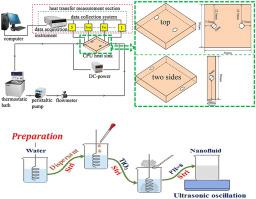Case Studies in Thermal Engineering ( IF 6.4 ) Pub Date : 2021-01-16 , DOI: 10.1016/j.csite.2021.100848 Tiantian Chen , Cong Qi , Jinghua Tang , Guiqing Wang , Yuying Yan

|
To improve CPU cooling performance, TiO2-water nanofluids with volume concentration 9% were used as the cooling mediumin. Nanofluids inlet and outlet positions play a crucial influence on the cooling performance, to further optimize the cooling property, the influence of nanofluids inlet and outlet positions (top and two side) on CPU cooling performance was numerically and experimentally studied by a two-phase lattice Boltzmann model and an experimental method respectively. The numerical simulation outcomes fit well with the experimental outcomes. Outcomes indicated that nanofluids can effectively reduce the average temperature of CPU by 4.54 °C at best in comparison with water under the identical operating conditions. CPU with inlet and outlet at top can reduce the average temperature by 8.49 °C at most compared with that at both two sides, and CPU temperature distribution is more uniform when inlet and outlet locate at top of CPU. Inlet and outlet at top are more suitable for CPU cooling. The results provide some guidance for the design of CPU cooling experiment system.
中文翻译:

纳米流体冷却的CPU系统优化的数值与实验研究
为了提高CPU冷却性能,TiO 2体积浓度为9%的水纳米流体用作冷却介质。纳米流体的入口和出口位置对冷却性能具有至关重要的影响,为了进一步优化冷却性能,通过两相晶格数值和实验研究了纳米流体的入口和出口位置(顶部和两侧)对CPU冷却性能的影响。玻尔兹曼模型和实验方法分别。数值模拟结果与实验结果非常吻合。结果表明,与相同工作条件下的水相比,纳米流体最多可以有效地将CPU的平均温度降低4.54°C。与两侧的CPU相比,顶部带有入口和出口的CPU最多可将平均温度降低8.49°C,当入口和出口位于CPU顶部时,CPU温度分布更均匀。顶部的入口和出口更适合CPU冷却。研究结果为CPU散热实验系统的设计提供了指导。











































 京公网安备 11010802027423号
京公网安备 11010802027423号